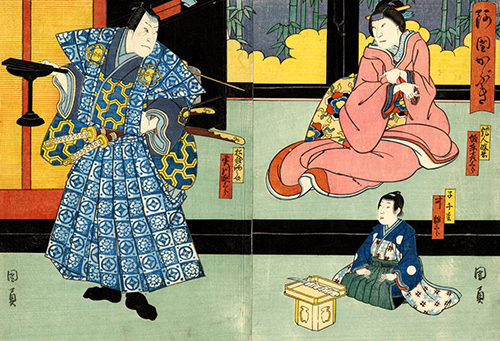Ukiyo-e, full of bamboo
September 3 (Tue) ‐December 1 (Sun), 2024
This museum exhibits ukiyo-e woodblock prints published in Osaka in the Edo period. Many of the ukiyo-e prints made in Osaka were portraits of popular kabuki actors performing in theatres around Dotombori.
The main subject of a portrait is a kabuki actor but its background such as scenery and props tell you the life style of the time. ‘Bamboo’ in particular, is heavily used and plays important roles in kabuki stories.
In this feature exhibition, we focus on bamboo depicted in ukiyo-e prints. Bamboo, being evergreen and having high fertility, was regarded as sacred. It was used not only in rituals but also in people’s daily lives as it is flexible to use for houses and everyday tools. Please enjoy kabuki actors and bamboos depicted in ukiyo-e.

Drawn by Kunikazu
“Keisei Okuni kabuki”
Bando Hikosaburo V (playing wet nurse Masaoka)
Kano Hinasaburo (playing childhood Senmatsu)
Jitsukawa Enzaburo (playing Matsugaetekinosuke)
‘Meiboku Sendai Hagi’ and ‘Bamboo and sparrow’
‘Meiboku Sendai Hagi’ was based on a real feud in the Date family of Sendai in the Edo period. But the drama was set during the Muromachi period and the names were changed to avoid censorship (Date Tsunamune was changed to Ashikaga Yorikane, Harada Kai was changed to Nikki Danjo). In ukiyo-e prints, confrontation scenes of Yorikane and Takao, Masaoka and Yashio, and Onosuke and Nikki Danjo are depicted respectively.
The first act of ‘Meiboku Sendai Hagi’ is named ‘Hanamizubashi no ba’. Ashikaga Yorikane, who frequently goes to pleasures quarter, attacks courtesan Takao after falling into gang’s trap who plans to take over the Ashikaga family. In the second act scene 1 ‘Goten no ba’, the wet nurse Masaoka watches her son Senmatsu being killed by Yashio. Masaoka does so in order to protect Tsuruchiyo, her young master, who has taken over as the head of the family after his father Yorikane is forced to retire. The forces trying to take over the Ashikaga family misunderstands that Masaoka is on their side and sends a covenant under joint signature to her. In the second act scene 3 ‘Yukashita no ba’, Arajishi Otokonosuke, a faithful retainer of Yorikane finds a large rat with the covenant in its mouth when he is guarding secretly below the floor. The rat turns out to be Nikki Danjo. In the third act scene 2 ‘Ninjo no ba’, Nikki Danjo stabs Gekizaemon who is guarding Tsuruchiyo at the court where Hosakawa Katsumoto exposes a gang’s trick.
The Date family’s crest is ‘bamboo and sparrow’, which is said to be given by the Uesugi family as a gift when the Date family adopted a child of the Uesugi family. Yorikane’s costume’s motif is ‘bamboo and sparrow’, the Date family’s crest.
Bamboo in kabuki plays
Ukiyo-e titled ‘Actor Ichikawa Danjuro as Takenuki Goro’ (Tokyo National Museum), painted by Torii Kiyomasu, depicts a man who is trying to pull up bamboo bulging muscles and turning his body red. This ukiyo-e was made at the time when ukiyo-e were still painted by a paintbrush. A dynamic performance by Ichikawa Danjuro describes the Ichikawa family’s forcefulness and emphasizes the strong flexibility of bamboo.
Bamboo appears in various situations in kabuki plays. Gates, fences, chairs and tools made by bamboo are passed down to this day as Japanese culture. Enjoy ukiyo-e prints in which kabuki actors perform using bamboo props.
Costumes with bamboo and bamboo grass patterns
Bamboos keep straight and green throughout the year and highly fertile, and are often used in shrine services and rituals. It is used for Kadomatsu (the New Year’s decorative pine tree), groundbreaking ceremony and Tanabata festival (star festival on July 7th). Bamboos play important roles when people pray to god.
Bamboo patterns are used in kabuki plays as a symbol of good luck. Bamboo symbolizes long life because it grows straight. A bamboo knot symbolizes moderation and a bamboo sprout is a symbol of prosperity of descendants. Combinations of the pine, bamboo and plum (sho-chiku-bai) and combinations of bamboo, plum, orchid and chrysanthemum (shikunshi) are both regarded as auspicious. Enjoy ukyo-e and look for the elaborate bamboo pattern depicted in it.
Murasaki Shikibu Genji Karuta
We introduce the ukiyo-e representation of ‘The Tale of Genji’ we exhibited this spring which received good reviews. Our collection ‘Murasaki Shikibu Genji Karuta’ is illustrated by Utagawa Kunisada II. It illustrates Edo customs, not Heian customs that the original tale describes.
Utagawa school’s ‘Genji-e’ became popular after ‘Nise Murasaki Inaka Genji’, long scrolls of novel by Ryutei Tanehiko, with the illustrations by Utagawa Kunisada I was published. Utagawa Kunisada I produced a unique character of Hikaru Genji (different from the original hero in the Tale of Genji) and a new genre of ‘Genji-e’ was created.
‘Murasaki Shikibu Genji Karuta’, illustrated by Utagawa Kunisada II, depicts the scenes from ‘The Tale of Genji’ but also includes lyrics of Noh songs and other stories.
Enjoy the famous scenes of ‘The Tale of Genji’ and its Edo-style interpretation. The theme of this feature exhibition is ‘full of bamboo’, so ukiyo-e prints that depict bamboos in various forms are picked up and being exhibited.